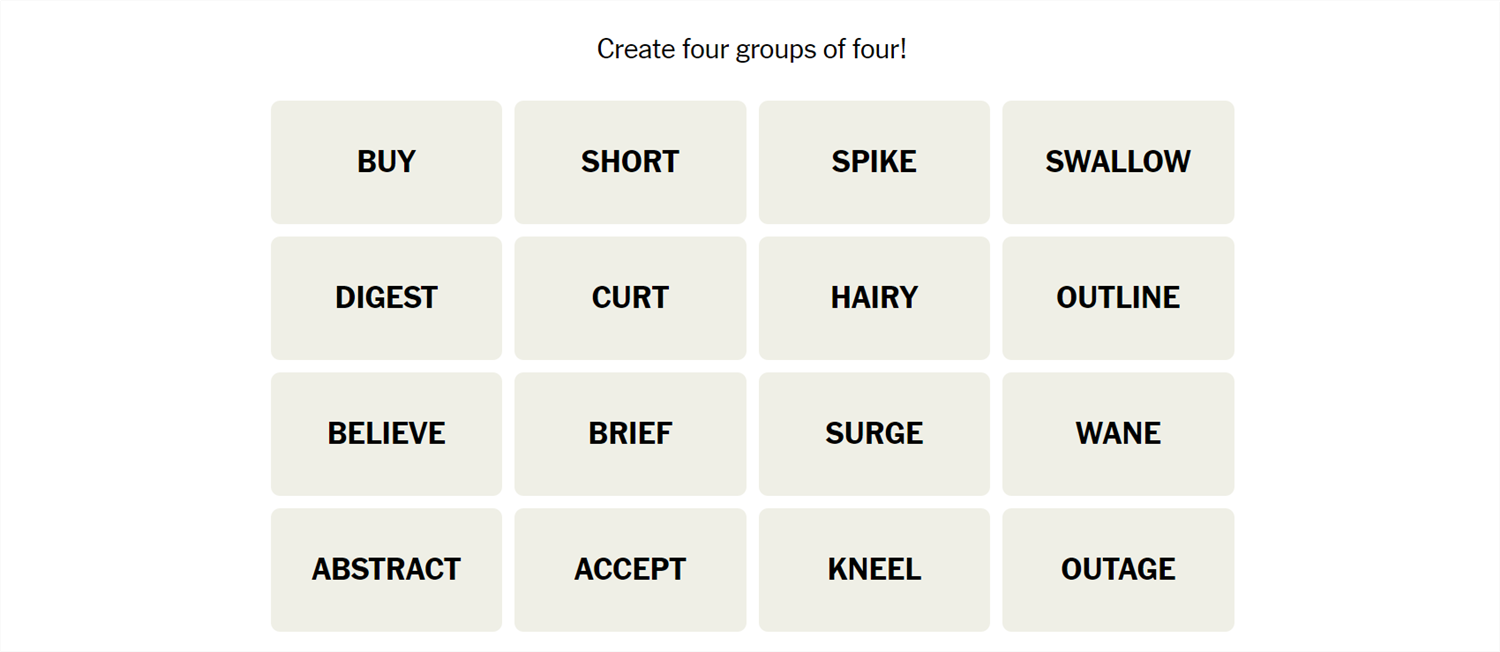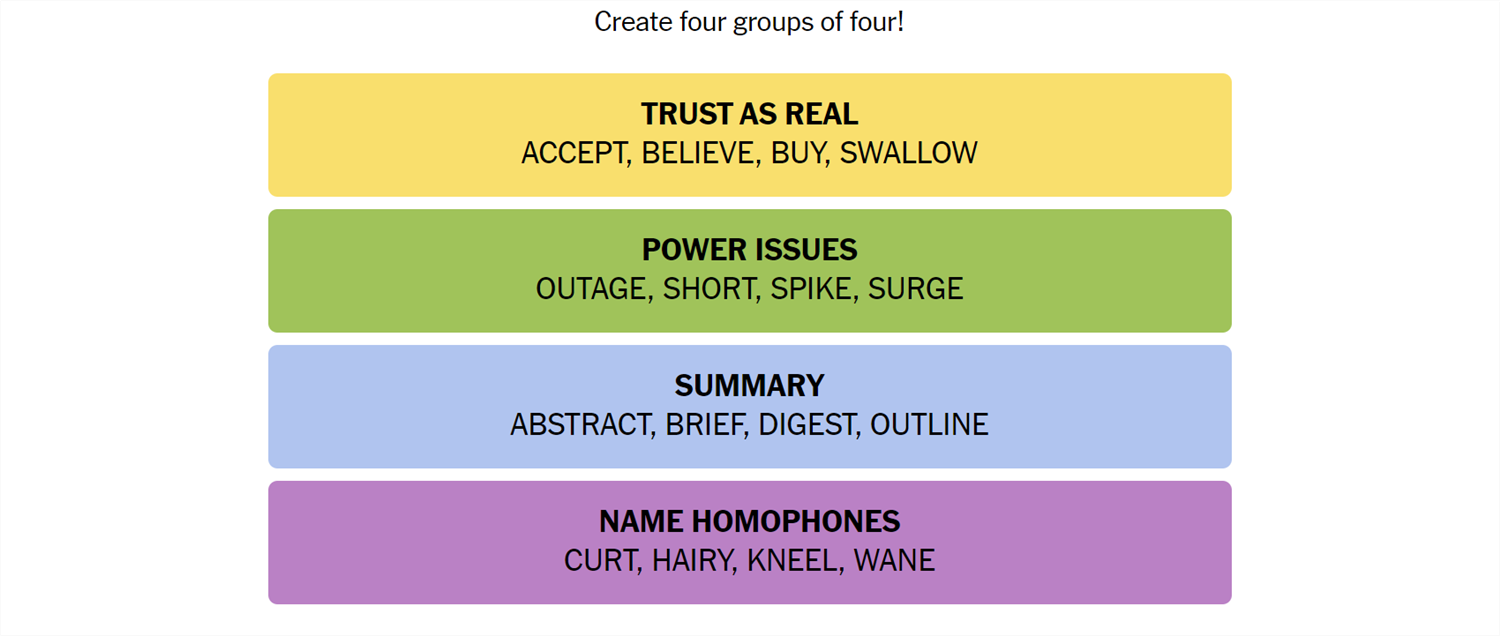Connections is a game from the New York Times that challenges you to find the association between words. It sounds easy, but it isn’t—Connections categories can be almost anything, and they’re usually quite specific. If you need a hand getting the answers, we’ve got you covered.
What Is Connections?
Connections is a game from the New York Times. The objective is simple: sort 16 words into groups of 4. Each group of words will be connected by some common idea or theme. That common element could be anything. We have seen everything from games that rely on the number of letters in the words to categories that require you to spot an extra letter at the end of the word. Sometimes they’re references to economics, other times they reference fairy tales. There is no telling what sort of association there will be between words.
Once you’re confident you understand the connection, select 4 words, then hit “Submit.” You have only four attempts in total, so don’t be too guess-happy.
Hints for Today’s Connections Categories
Here are a few small hints for the 321st Connections game to get you started:
- Yellow: Almost Taken on Faith.
- Green: Electricity.
- Blue: Everything Important.
- Purple: They Sound the Same.
What Are Today’s Connections Categories?
If you still need help, the actual categories are:
- Yellow: Trust as Real
- Green: Power Issues
- Blue: Summary
- Purple: Name Homophones
Today’s NYT Connections Answers
Trust as Real (Yellow):
Accept, Believe, Buy, Swallow
Power Issues (Green):
Outage, Short, Spike, Surge
Summary (Blue):
Abstract, Brief, Digest, Outline
Name Homophones (Purple):
Curt, Hairy, Kneel, Wane
How Did We Solve This Connections Game?
April 27th seemed easier than yesterday’s game.
I spotted Green—”Power Issues”—almost immediately, likely because I’ve recently experienced a power outage. The words were outage, short, spike, and surge.
The next category I spotted, Blue, was also pretty quick. Abstract was the first word I noticed, and luckily, I interpreted it in the context of a summary, like you’d find at the beginning of a scientific publication. With that in mind, brief and outline seemed very likely to be related too. The only word that didn’t jump out quickly was digest. The category, as you might expect, was “Summary.”
Accept and believe seem like a pretty natural combination, too. They don’t mean exactly the same thing, but they’re similar. Looking for words that are similar turned up buy and swallow. Those two felt a little bit off, probably because they’re much more colloquial than the first two. However, sticking the 4 words together finished out Yellow, which was “Trust as Real.”
That left only Purple. The connection never came to me, despite rolling it around in my head for several minutes. It turns out that all the words are Name Homophones: Kurt, Harry, Neil, and Wayne.
How Do You Guess Connections Categories?
There is no quick, reliable way to approach Connections like there is with Wordle, since Connections isn’t algorithmic. However, there are a few things to keep in mind that can help.
- Look for similar parts of speech. Are some words verbs and others nouns? Are some adjectives? Try mentally grouping them based on those categories and see if any other patterns jump out at you.
- Are the words synonyms? Sometimes categories will just be synonyms for a phrase, or very close to synonyms. Don’t rely too closely on this, though. Occasionally, Connections will deliberately throw in words that are sometimes synonyms to mislead you.
- Try saying the words. Sometimes, saying the words helps. One puzzle we saw included the words go, rate, faster, clip, pace, speed, move, commute, and hurry—all of which are obviously related to the idea of motion. However, when you say them, it becomes a little more obvious that only four (go, move, hurry, faster) are things you’d actually say to prompt someone to get moving.
- Expect the red herring. Connections usually has words that could be plausibly, yet incorrectly, grouped together. Take the words Bud, Corona, and Light, as an example. You might instinctively see those three words together and assume they’re lumped together in a category related to beer—but they weren’t.
- Look for distinct words. If a word on your board doesn’t have multiple meanings or can really only be used in one context, try using that word as the basis for a category.
- Shuffle the board. Sometimes, moving words around will help you look at them in new ways.
If you didn’t solve this one, don’t feel too bad—there’s always tomorrow! And those words may align with a topic you’re interested in, giving you a leg up on the competition.





